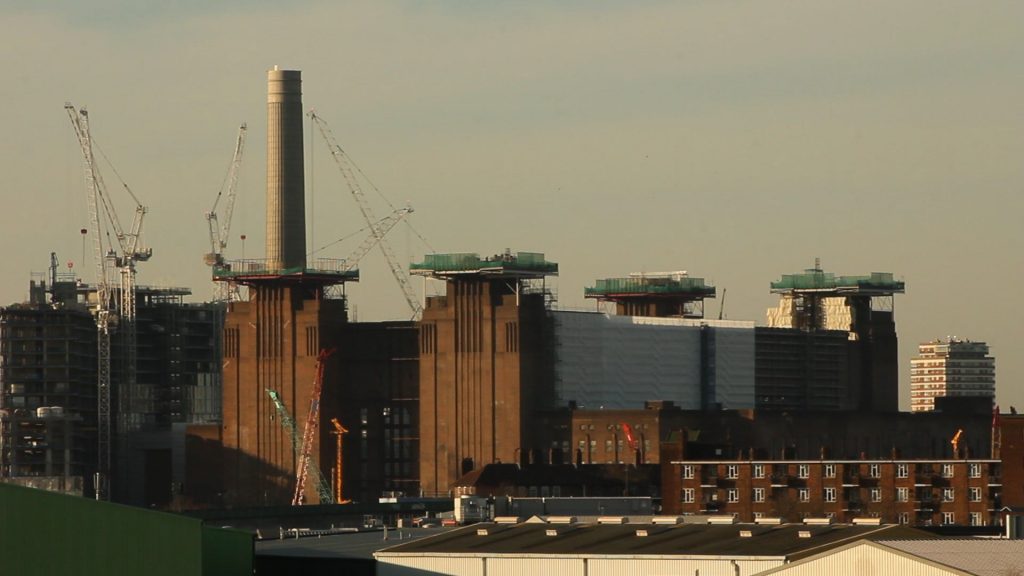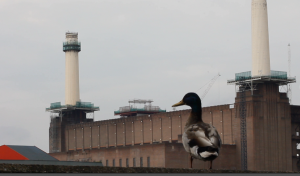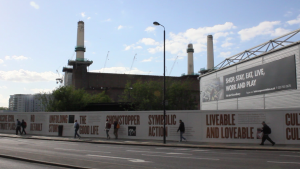English Version
Come mai i lavori di demolizione della ciminiera sudovest di Battersea Power Station sembrano essersi fermati?
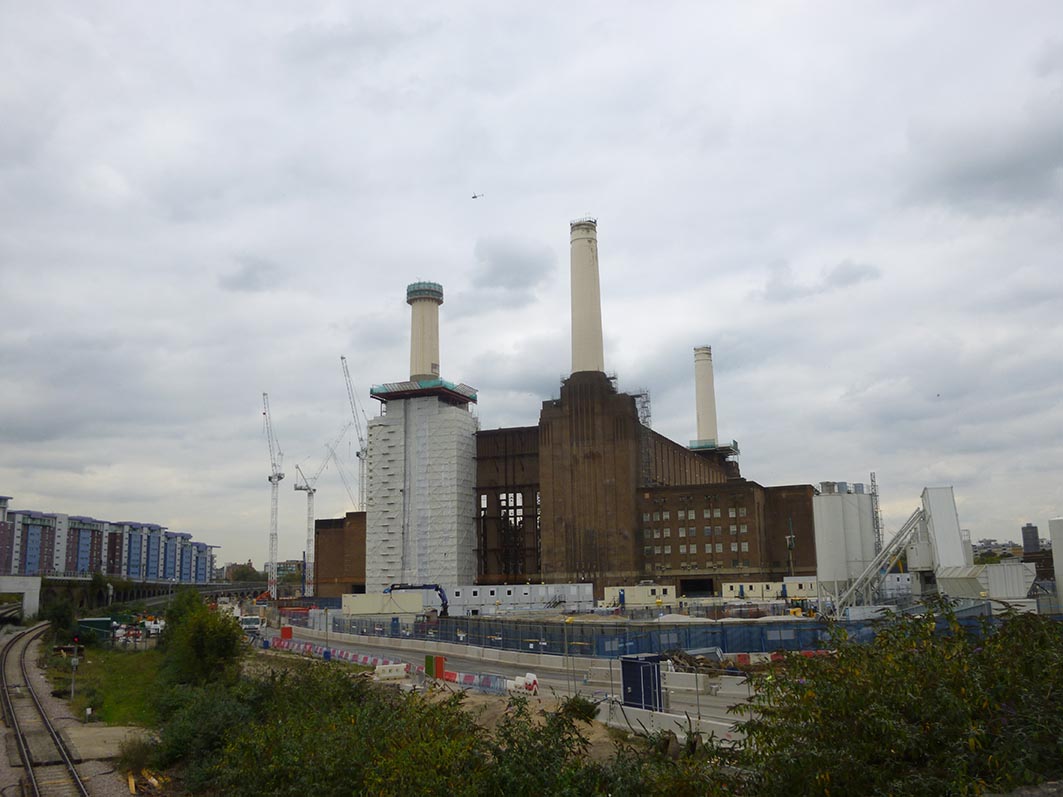
Come apparivano le ciminiere di Battersea Power Station il 27 settembre scorso

Le ciminiere di Battersea Power Station il 21 ottobre
Il progetto si è forse incagliato su qualche scoglio tecnico – le ciminiere sono molto più resistenti di quanto la Battersea Power Station Development Company sia disposta ad ammettere – o dipende dall’andamento dell’economia globale e si tratta, quindi, di un indicatore sulla vulnerabilità del piano finanziario del progetto? Il modello economico seguito dagli attuali proprietari, così come dai precedenti, è alquanto precario basandosi in gran parte sull’idea di un mercato immobiliare britannico in continua crescita.
Guarda caso le previsioni economiche attuali non guardano al bello. Il mercato immobiliare, secondo le opinioni degli esperti, è in stagnazione e, a Londra, corre il rischio di deflazione.
Simon Rubinsohn, Chief Economist del Royal Institution of Chartered Surveyors, in un articolo mercato immobiliare nel Regno Unito afferma:
“As a result of the rebalancing in demand and supply, house price growth across the UK appears to be moderating […] prices are still projected to rise nationally over the next year and expected to increase by 2.6% on a 12 month view (compared with around 4% at the start of the year)”
La sterlina sta diventando sempre più forte nei confronti dell’Euro (Milano e Parigi sono obbiettivi per il mercato della Battersea Power Station Development Company), rendendo Londra una città meno attrente in cui investire, con tassi di interesse in crescita.

(www.xe.com)
Il partito laburista, in caso di successo alle elezioni generali di Maggio 2015 – possibilità dovuta al fatto che l’alternaza tra i due maggiori partiti della politica britannica è inevitabile come il movimento di un metronomo – ha promesso la cosiddetta “Mansion Tax”, una tassazione aggiuntiva su tutti gli immobili di valore superiore a 2 milioni di sterline (qui è possibile leggere l’opinione del Royal Institution of Chartered Surveyors sulla Mansion Tax).
Poi c’è la crisi abitativa, causata in gran parte dalla vendita di immobili londinesi a investitori stranieri, i quali non hanno nessuna intenzione di vivere nelle case che comprano. Chiunque vinca le prossime elezioni dovrà mettere mano a questo problema, e qualuque possibile soluzione avrà inevitabili ricadute sul mercato immobiliare.
The Financial Times, in un recente articolo, sembra supportare le nostre preoccupazioni:
“Uncertainty around new property taxes, the strength of the pound on global currency markets and the introduction last year of a tax on homes held through companies have all contributed to the slowdown, according to those involved in trading properties.”
Lo stesso articolo è corredato da una fotografia impressionante della situazione che sta attraversando il mercato immobiliare.
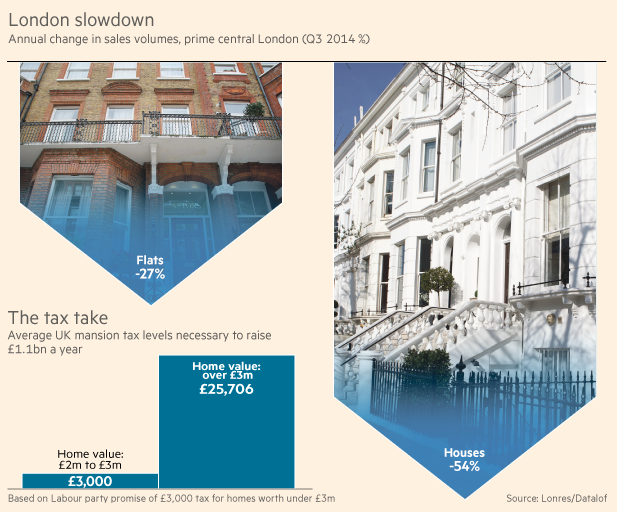
Dati riguardanti il mercato immobiliare britannico, pubblicati su The Financial Times.
Può darsi che l’enfasi riposta sui piani di vendita a investitori stranieri, quando c’è abbondanza di ricchi anche nel Regno Unito, sia dovuta al fatto che gli investitori locali siano più difficili da convincere visto che sono meglio informati. Gli investitori stranieri, che fondano i loro giudizi su impressioni artistiche e futuristiche, sono probabilmente inconsapevoli dell’olezzo disgustoso proveniente dall’impianto di smaltimento dei rifiuti presente nell’area, con le centinaia di camion che quotidianamente vi riversano fatiscenti carichi d’immondizia.
L’eclettico Sindaco di Londra Boris Johnson, anche nella sua versione più populista, fa il doppio gioco: va in tour in Cina per promuovere investimenti nel mercato immobiliare londinese, mentre al pubblico londinese indica proprio questo modello di mercato come causa della cronica mancanza di abitazioni.

Boris Johnson interviene al lancio delle vendite del London City Island, in un evento organizzato dall’impresa Ballymore il 18 ottobre ad Hong Kong. (Fonte: www.ballymoregroup.com)
Può darsi che si tratti di una coincidenza, ma nella stessa settimana in cui la demolizione della ciminiera si è fermata sono stati pubblicati resoconti che indicano come la bolla immobiliare cinese stia per esplodere presto, forse già nel 2015, con catastrofiche ricadute sull’economia globale e sulla finanza internazionale – con la possibilità di innescare una crisi globale.
Come riportato recentemente da Bloomberg:
“The Chinese crash might make 2008 look like a garden party. As the risks of one increase, it’s worth exploring how it might look. After all, China is now the world’s biggest trading nation, the second-biggest economy and holder of some $4 trillion of foreign-currency reserves. If China does experience a true credit crisis, it would be felt around the world.
[…]
The potential for things careening out of control in China are real. What worries bears such as Patrick Chovanec of Silvercrest Asset Management in New York, is China’s unaltered obsession with building the equivalent of new “Manhattans” almost overnight even as the nation’s financial system shows signs of buckling. As policy makers in Beijing generate even more credit to keep bubbles from bursting, the shadow banking system continues to grow.”
Questa settimana la Battersea Power Station Development Company ha portato i suoi appartamenti di lusso in una campagna di vendite in giro per il mondo. Tre città raggiunte dalla campagna sono Pechino, Shangai e Hong Kong, tutte particolarmente esposte agli alti e bassi dell’economia cinese.
I nuovi proprietari non sono molto diversi da quelli precedentivi – sono solo più bravi in PR e hanno un migliore accesso ai mercati internazionali. Come in passato, nonostante gli eccellente battage pubblicitario sostenga che “finalmente i lavori sono iniziati”, sotenuto senza pudore dall’English Heritage, l’unica cosa che i nuovi proprietari hanno fatto in realtà è stato demolire – stanno abbattendo le ciminiere, demolendo la deliziosa e protetta Victorian pumping station e rimuovendo le iconiche (e protette) gru.
In altre parole i nuovi proprietari stanno facendo il loro gioco con la Battersea Power Station. Vendono oggi immagini fantastiche di ciò che POTREBBE essere costruito in futuro.
Ci chiediamo che tipo di garanzie vengano fornite agli eventuali acquirenti stranieri circa il fatto che gli apparatamenti che stanno comprando sulla carta vengano effettivamente realizzati. Alla fine, avendo costoro più soldi che giudizio, forse gli non importa più di tanto.
Click Battersea Power Station for more blogs
See our Battersea Power Station project pages for more information and videos.
Or visit PlanA our general blog on urbanism, planning and architecture.
Spectacle homepage
Like Spectacle Documentaries on Facebook
Follow SpectacleMedia on Twitter

